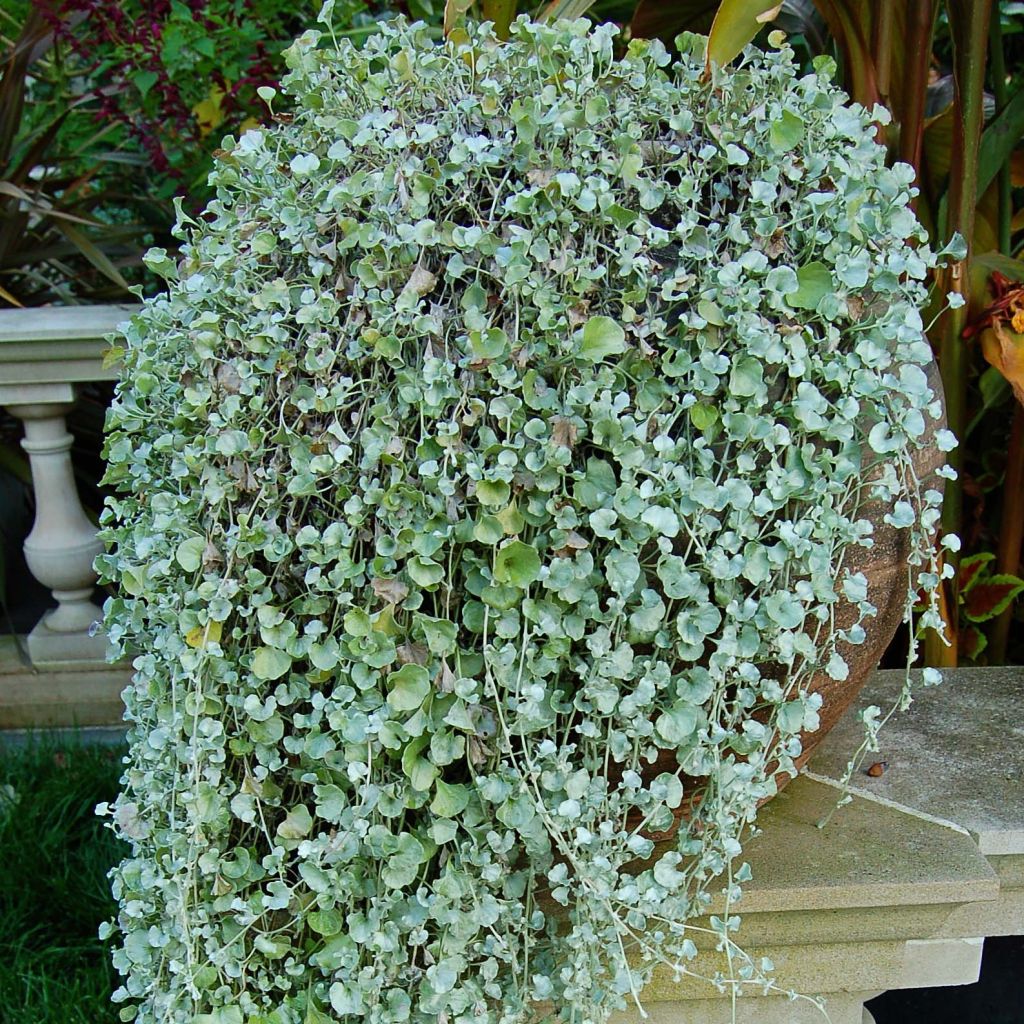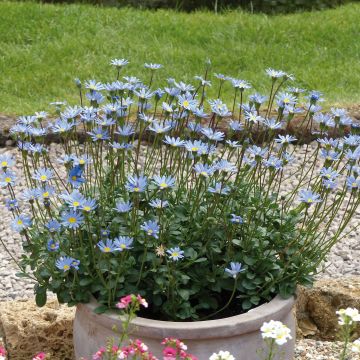

Dichondra Silver Falls - Silver ponysfoot


Dichondra Silver Falls - Silver ponysfoot


Dichondra Silver Falls - Silver ponysfoot
Dichondra Silver Falls - Silver ponysfoot
Dichondra argentea Silver Falls
Silver nickel vine
Delivered in good condition but have grown very little.
Ank, 16/09/2024
This item cannot be shipped to the selected country
Delivery charge from €5.90
Delivery charge from €5.90
More information
Schedule delivery date,
and select date in basket
This plant carries a 6 months recovery warranty
More information
We guarantee the quality of our plants for a full growing cycle, and will replace at our expense any plant that fails to recover under normal climatic and planting conditions.
From €5.90 for pickup delivery and €6.90 for home delivery
Express home delivery from €8.90.
From €5.90 for pickup delivery and €6.90 for home delivery
Express home delivery from €8.90.

Does this plant fit my garden?
Set up your Plantfit profile →
Description
Dichondra argentea 'Silver Falls' is an exceptional and unforgettable plant. It is a frost-tender perennial with a spreading habit, covered in small, almost pearly, round foliage. It enhances all floral compositions with its somewhat fairy-like elegance. It is also a drought-resistant ground cover. It is usually grown as an annual in our cooler climates. It should be planted in full sun or partial shade, in humus-bearing and well-drained soil.
Dichondra 'Silver Falls' belongs to the Convolvulaceae family, just like bindweeds and morning glories. In its country of origin, which extends from Mexico to the southern United States and down to South America, Dichondra is a plant of the undergrowth or forest edge. This tender perennial plant has a spreading growth, producing long stems that root at each node. This characteristic helps it to cascade, overflowing from all containers in search of soil that can accommodate it. Growing 1 to 3cm (1in) tall, its foliage spreads to cover an area of at least 60cm (24in) in length and 30cm (12in) in width. The stems are covered with tiny round leaves, shaped like beans or hearts, and undulating like petals. They are a very soft green that disappears under a silvery sheen.
Sometimes used as an alternative to grass in low-traffic areas, Dichondra 'Silver Falls' is especially popular in pots, window boxes on balconies, and hanging baskets. Its silvery foliage complements the purple and black of morning glories and ophiopogons, the blue flowers of scaevolas, and the vibrant red or pink of trailing or upright geraniums. It can be planted en masse along pathways or at the base of perennials and shrubs, in rockeries and on banks. It will not tolerate temperatures below -8°C (17.6°F). Its lack of hardiness will be forgiven as it can be replanted the following year.
Please be aware that our young plug plants are professional products intended for experienced gardeners. Upon receipt, repot and store them under cover (veranda, greenhouse, cold frame) at a temperature above 14°C (57.2°F) for a few weeks before planting them outdoors, once the risk of frost has definitely passed.
Report an error about the product description
Dichondra Silver Falls - Silver ponysfoot in pictures




Flowering
Foliage
Plant habit
Botanical data
Dichondra
argentea
Silver Falls
Convolvulaceae
Silver nickel vine
Cultivar or hybrid
Other Annuals A to Z
Planting and care
Plant your Dichondra argentea 'Silver Falls' in partial shade or non-burning sunlight. In shade, the foliage loses its silver sheen. These plants require light, humus-bearing soil, even if it is calcareous. They tolerate dry soil quite well and dislike stagnant humidity. Plant it in well-prepared and lightened soil, either in the ground or in a pot. In pots, they need to be watered more regularly.
They are delicate perennials that are usually grown as annuals. However, you can extend the display of their foliage to autumn and winter by bringing them indoors at the first sign of frost. Outdoor cultivation is possible by the seaside, with proper winter mulching. Prune lightly in March.
Planting period
Intended location
Care
-
, onOrder confirmed
Reply from on Promesse de fleurs
Plug plants - Annuals
Haven't found what you were looking for?
Hardiness is the lowest winter temperature a plant can endure without suffering serious damage or even dying. However, hardiness is affected by location (a sheltered area, such as a patio), protection (winter cover) and soil type (hardiness is improved by well-drained soil).

Photo Sharing Terms & Conditions
In order to encourage gardeners to interact and share their experiences, Promesse de fleurs offers various media enabling content to be uploaded onto its Site - in particular via the ‘Photo sharing’ module.
The User agrees to refrain from:
- Posting any content that is illegal, prejudicial, insulting, racist, inciteful to hatred, revisionist, contrary to public decency, that infringes on privacy or on the privacy rights of third parties, in particular the publicity rights of persons and goods, intellectual property rights, or the right to privacy.
- Submitting content on behalf of a third party;
- Impersonate the identity of a third party and/or publish any personal information about a third party;
In general, the User undertakes to refrain from any unethical behaviour.
All Content (in particular text, comments, files, images, photos, videos, creative works, etc.), which may be subject to property or intellectual property rights, image or other private rights, shall remain the property of the User, subject to the limited rights granted by the terms of the licence granted by Promesse de fleurs as stated below. Users are at liberty to publish or not to publish such Content on the Site, notably via the ‘Photo Sharing’ facility, and accept that this Content shall be made public and freely accessible, notably on the Internet.
Users further acknowledge, undertake to have ,and guarantee that they hold all necessary rights and permissions to publish such material on the Site, in particular with regard to the legislation in force pertaining to any privacy, property, intellectual property, image, or contractual rights, or rights of any other nature. By publishing such Content on the Site, Users acknowledge accepting full liability as publishers of the Content within the meaning of the law, and grant Promesse de fleurs, free of charge, an inclusive, worldwide licence for the said Content for the entire duration of its publication, including all reproduction, representation, up/downloading, displaying, performing, transmission, and storage rights.
Users also grant permission for their name to be linked to the Content and accept that this link may not always be made available.
By engaging in posting material, Users consent to their Content becoming automatically accessible on the Internet, in particular on other sites and/or blogs and/or web pages of the Promesse de fleurs site, including in particular social pages and the Promesse de fleurs catalogue.
Users may secure the removal of entrusted content free of charge by issuing a simple request via our contact form.
The flowering period indicated on our website applies to countries and regions located in USDA zone 8 (France, the United Kingdom, Ireland, the Netherlands, etc.)
It will vary according to where you live:
- In zones 9 to 10 (Italy, Spain, Greece, etc.), flowering will occur about 2 to 4 weeks earlier.
- In zones 6 to 7 (Germany, Poland, Slovenia, and lower mountainous regions), flowering will be delayed by 2 to 3 weeks.
- In zone 5 (Central Europe, Scandinavia), blooming will be delayed by 3 to 5 weeks.
In temperate climates, pruning of spring-flowering shrubs (forsythia, spireas, etc.) should be done just after flowering.
Pruning of summer-flowering shrubs (Indian Lilac, Perovskia, etc.) can be done in winter or spring.
In cold regions as well as with frost-sensitive plants, avoid pruning too early when severe frosts may still occur.
The planting period indicated on our website applies to countries and regions located in USDA zone 8 (France, United Kingdom, Ireland, Netherlands).
It will vary according to where you live:
- In Mediterranean zones (Marseille, Madrid, Milan, etc.), autumn and winter are the best planting periods.
- In continental zones (Strasbourg, Munich, Vienna, etc.), delay planting by 2 to 3 weeks in spring and bring it forward by 2 to 4 weeks in autumn.
- In mountainous regions (the Alps, Pyrenees, Carpathians, etc.), it is best to plant in late spring (May-June) or late summer (August-September).
The harvesting period indicated on our website applies to countries and regions in USDA zone 8 (France, England, Ireland, the Netherlands).
In colder areas (Scandinavia, Poland, Austria...) fruit and vegetable harvests are likely to be delayed by 3-4 weeks.
In warmer areas (Italy, Spain, Greece, etc.), harvesting will probably take place earlier, depending on weather conditions.
The sowing periods indicated on our website apply to countries and regions within USDA Zone 8 (France, UK, Ireland, Netherlands).
In colder areas (Scandinavia, Poland, Austria...), delay any outdoor sowing by 3-4 weeks, or sow under glass.
In warmer climes (Italy, Spain, Greece, etc.), bring outdoor sowing forward by a few weeks.























































